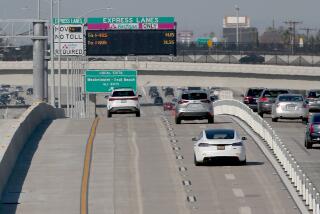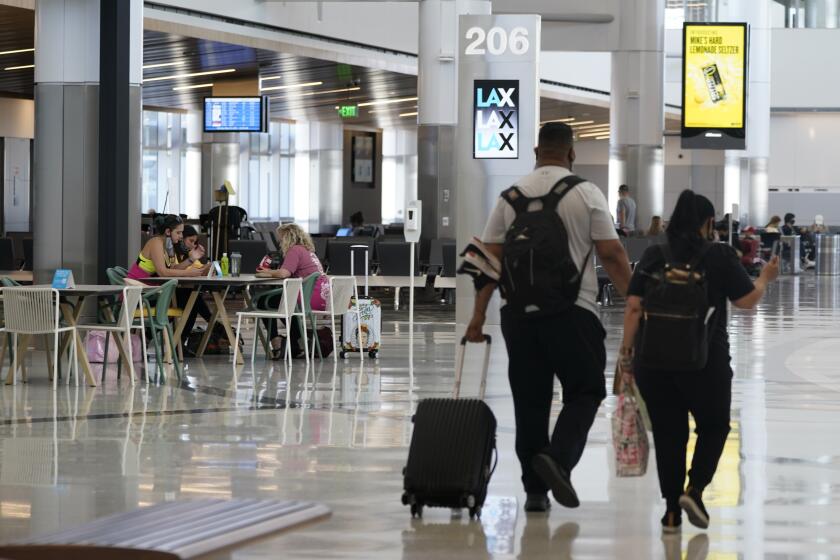Ventura Freeway Next? : Plans for Car-Pool Lanes Hit Traffic
- Share via
Bill Hildebrand is a battle-scarred veteran of perhaps the most famous commuter controversy in California freeway history, one that some fear could be echoed on the heavily congested Ventura Freeway.
Hildebrand, who was living in South Gate and commuting to West Los Angeles, remembers spending hours stuck in traffic on the Santa Monica Freeway during the ill-fated 1976 diamond lane car-pool experiment. The ordeal, he recalls, left him “frustrated and angry.”
But now, whenever he can find a co-worker who is willing, Hildebrand car-pools from his home in Diamond Bar to his job at Pacific Mutual Life Insurance Co. in Newport Beach, using the year-old commuter lane on the Costa Mesa Freeway.
“The trip used to take an hour and a half to two hours,” said the 30-year-old policy services manager. “When we use the commuter lane, we save 20 to 40 minutes, which is nice. . . . I think the commuter lanes are a good idea.”
Transportation experts agree that the Santa Monica Freeway diamond lane experiment was a disaster. Although many people used the commuter lane, which was converted from a general-purpose lane, overall freeway congestion actually worsened and the accident rate soared more than 200%. After five months, citing an adverse environmental ruling in federal court and public outrage, the state ended the experiment.
Ten years later, there are still no car-pool lanes on the Santa Monica Freeway. But in other traffic-choked corridors throughout the United States, they are becoming increasingly familiar sights on freeways and major surface streets, even as freeway construction is slowed.
In Southern California alone, the special lanes have appeared on the Costa Mesa and Riverside freeways in Orange County, and the Century Freeway, like a new freeway in Arizona, is being built from scratch with a car-pool lane already incorporated.
Caltrans now is proposing to install a car-pool lane on several more freeways, including the eastbound Ventura Freeway between Topanga Canyon Boulevard and the Hollywood Freeway. But the Ventura Freeway plan has drawn heavy criticism from some local legislators and residents, who say commuter lanes cause accident rates to jump and unfairly punish those who cannot car-pool.
A 68-member advisory committee formed by Caltrans is scheduled to vote Feb. 19 on whether the new eastbound lane should be restricted to car pools and buses or open to all vehicles. Caltrans officials have said they will be bound by the vote.
Assemblyman Tom McClintock (R--Thousand Oaks) is so upset about the proposed lane that he has introduced a bill that would ban such lanes in California. McClintock said his intent is to provoke a legislative debate in Sacramento about the merits of the special lanes.
“I’m not convinced there’s enough scientific evidence to prove that they’re worthwhile,” he said.
McClintock wants the new Ventura Freeway lane, which would be created by narrowing existing lanes from 12 feet to 11 and using the median strip, to be open to all traffic.
Special Lanes First Appeared in 1939
The idea of giving preferential treatment to multi-occupant vehicles is hardly new. According to one report, the practice began in 1939, when a lane was reserved for buses on North Sheridan Road in Chicago. Similar lanes were established in several cities between 1948 and 1968, but car pools and van pools were not included until 1971, when they were allowed to enter a lane previously restricted to buses on the toll plaza of the San Francisco-Oakland Bay Bridge.
Influenced by the energy crisis in the early- to mid-1970s, state and federal officials began promoting commuter lanes as a way to reduce both fuel consumption and exhaust emissions. The current boomlet in construction of such lanes, says Peter B. Giles, president of the Santa Clara County Manufacturing Group, owes its start to employers and developers concerned that congested freeways will limit economic growth and hinder the flow of workers from their homes to urban centers. The primary goal has shifted, he said, from saving energy to preserving mobility.
Frank Southworth of the Oak Ridge National Laboratory in Tennessee and Genevieve Giuliano of the University of California’s Institute of Transportation Studies, insist that most commuter lanes work well--as long as they meet certain criteria. Among other requirements, they said, the lanes should:
Serve suburban commuters who must reach a dense urban center.
Not punish drivers by taking a lane away from regular traffic.
Serve areas where average commute times have been steadily increasing.
Be physically separated from adjacent lanes, where possible.
Few car-pool lanes meet all these criteria.
For example, the car-pool lane on Interstate 93 in downtown Boston utilizes space taken away from regular traffic.
The car-pool lanes on both the Riverside and Costa Mesa freeways involve commutes to job sites spread along the entire route rather than centrally-located work destinations, which makes matching would-be ride-sharers more difficult. And neither project utilizes barriers.
Different Drivers
Moreover, unlike the commuter lanes on U.S. 101 in Marin County that serve San Francisco’s severely overcrowded business districts, the Riverside and Costa Mesa freeway lanes tend to serve drivers who have comparatively little trouble finding an inexpensive place to park their cars.
Some commuter lanes are plagued by high numbers of solo drivers who violate the rules, which usually restrict the lanes to vehicles carrying at least two, three, and sometimes four people.
In Boston, a traffic officer stands at a fork in the highway and motions violators into a lane that takes them 20 minutes out of their way, back toward the suburbs. In Seattle, motorists are encouraged to turn in violators by submitting license-plate information via a so-called “Hero” telephone hot line.
Violation rates once hovered near 20% for the car-pool lanes on Interstate 5 in Seattle but now are down around 7%, according to Kern Jacobson, planning and operations supervisor for the Washington State Department of Transportation.
Percentage Remains Stable
Despite the surge in construction of car-pool lanes, there has not been an accompanying increase nationally in the percentage of people sharing a vehicle between home and job. Indeed, ride-sharing organizations and U.S. Census Bureau statistics agree that only about 22% of U.S. commuters share rides to work--about the same as 16 years ago.
Researchers say the effectiveness of car-pool lanes is strongly affected by local life styles and politics.
For example, in 1982 New Jersey officials ended a commuter-lane experiment on the Garden State Parkway after a television station broadcast a videotape showing that no cars used the lane during a 1.5-minute period.
“The politicians are now so afraid of public reaction that they are having a hard time getting up the courage to try again, anywhere in the state,” said Jerrold Huggler, New Jersey’s chief of special transportation services. “And the traffic is now worse than ever.”
In Florida, rules restricting a lane on U.S. 1 in downtown Miami to car pools were rescinded after officials found that the lane drew passengers away from Dade County’s new rail-transit line and partially blocked access to rail-transit stations.
Accidents Delay Completion
In Orlando, the completion of 31 miles of car-pool lanes on Interstate 4 was delayed because three serious accidents raised questions about safety, and a similar project near Boston was canceled because of bad publicity after a state transportation worker was fatally struck by a truck.
The diamond lane experiment itself was the victim of poorly produced Caltrans’ data and quick media condemnation, said Palo Alto-based consultant John W. Billheimer in a little-noticed 1978 post-mortem written for the National Research Council, a science and engineering organization that advises federal agencies.
Billheimer concluded that the media were too quick to condemn Caltrans and was too willing to accept at face value any information provided by project opponents.
Some states do not even bother to do “before” and “after” comparisons of accident rates in connection with the introduction of car-pool lanes. In most cases for which such data is available, evidence shows that accident rates generally have increased after the preferential lanes were introduced. Southworth’s 82-page Oak Ridge study of car-pool lanes, considered to be one of the most definitive, devotes only two pages to the subject of safety.
The car-pool lanes recognized as the most successful in the United States stretch for 11 miles on Shirley Highway in the northern Virginia suburbs of Washington. The two lanes are reversible in direction to accommodate either the morning or evening rush, and are physically separated from regular traffic.
Occupany Rates
According to Southworth’s report, an average of 8,614 people shared rides or used buses during the rush hour on the Shirley Highway in 1985, four times the average for each regular lane. Occupancy averaged 2.88 people per vehicle for all lanes during rush hours, the highest occupancy rate in the nation.
But two California projects are also near the top of the list.
The El Monte busway on the San Bernardino Freeway, also a physically separated lane, averaged 6,490 people per peak hour in 1984. Occupancy averaged 1.76 people for all lanes during the peak hour, the fifth-best peak-hour rate nationally.
Caltrans’ credibility has become an issue since it has a vested interest in making commuter lanes look good to the public. The agency has a major role in securing state and federal funds for such projects, and then oversees construction and operation of the freeways, helped by the California Transportation Commission.
In 1976, The Times did its own counts of vehicles and occupants during the Diamond Lane experiment, and the results worked to undermine Caltrans’ claims for the project. After doubts were raised about Caltrans’ accident-rate figures in Orange County, the local transportation commission asked for an independent study. It showed that accidents were increasing on the Costa Mesa Freeway for reasons that were not clear.
Assemblyman McClintock argues that it is a conflict of interest for Caltrans to advocate, seek funds for and build the car-pool lanes, and then analyze their success or failure while continually defending the projects against criticism. He has asked the state auditor general’s office to investigate whether Caltrans’ car-pool lane studies have been objective.
Southworth said his and other studies deliberately avoid combining violation rates, extra capacity and other statistics into a single-number rating system.
“I’ve tried it,” he explains. “It doesn’t work.”
Some say that no matter what is tried on freeways, drivers won’t be satisfied.
“They don’t consider themselves responsible for the problem,” said Peter Valk, president of Pasadena-based Transportation Management Services, citing attitude surveys. “And they want others to take care of the problem for them.”
More to Read
Sign up for Essential California
The most important California stories and recommendations in your inbox every morning.
You may occasionally receive promotional content from the Los Angeles Times.










